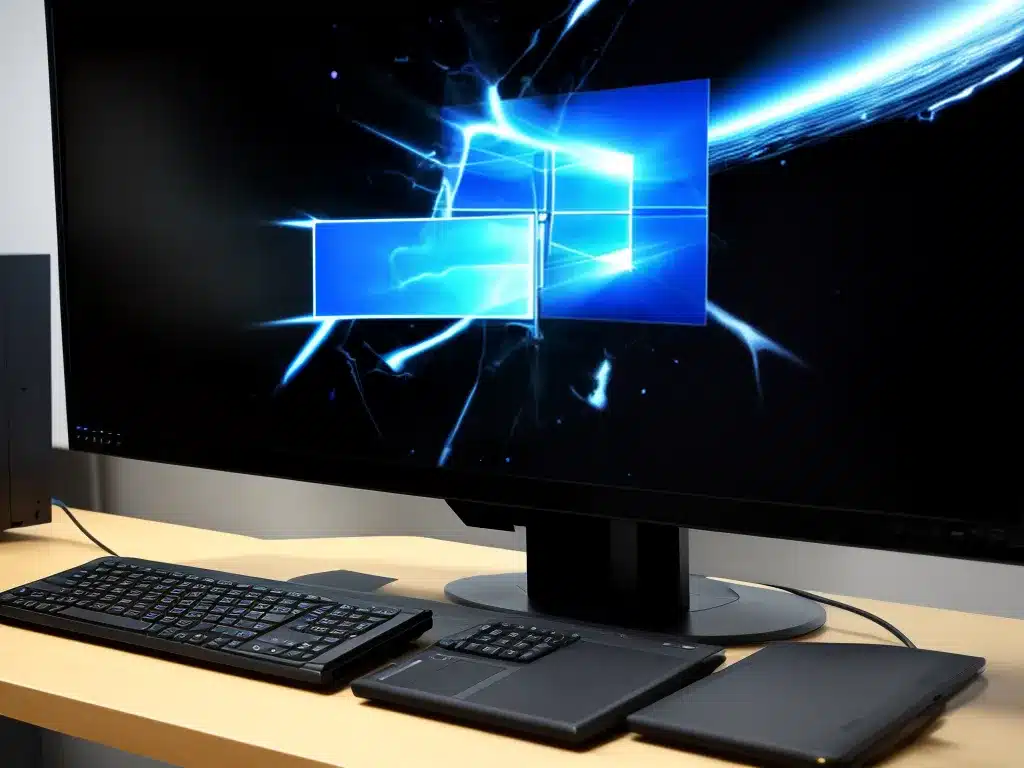
The dreaded black screen that suddenly appears when using your Windows PC can be incredibly frustrating. As the screen goes dark, panic starts to set in about potential data loss or hardware failure. However, in many cases, this black screen of death can be fixed with a few strategic troubleshooting steps.
What Causes the Black Screen of Death?
The black screen of death, sometimes abbreviated to BSoD or BSOD, has a number of potential causes:
-
Hardware failure – Faulty RAM, a failing hard drive, overheating components, or problems with the motherboard can lead to a black screen with an error code.
-
Driver conflicts – Incompatible or outdated drivers can sometimes cause Windows to crash and show the black screen.
-
Power issues – An unexpected power outage or surge while Windows is running sometimes corrupts key system files needed for startup.
-
Software incompatibility – Some software programs may conflict with Windows and cause critical system files to become damaged.
-
Malware infection – Viruses and other malicious software can sometimes modify or delete important Windows system files.
So in summary, both software and hardware issues can potentially lead to the black screen of death appearing.
Initial Troubleshooting Steps
When faced with the black screen, there are a few preliminary things to try:
-
Restart the computer – A simple restart will fix many black screen issues caused by software conflicts or temporary software glitches.
-
Start in Safe Mode – Restart and enter Safe Mode, which loads only the essential drivers and software. If the black screen doesn’t appear in Safe Mode, this points to a driver or software issue.
-
Check connections – Make sure all cables are properly plugged in, including the power cord, monitor cable, and other peripheral devices. Loose connections can cause black screen errors.
-
Boot from installation media – Try booting from a Windows installation USB or DVD drive. If this works, it indicates the core Windows system has become corrupted.
These basic steps allow you to quickly determine if the black screen of death stems from a superficial issue or a deeper system problem.
Troubleshooting Hardware Issues
If the black screen persists even after these initial steps, it’s time to start investigating hardware failures:
-
Check RAM – Open the case and reseat the RAM modules. If you have multiple RAM sticks, remove them one at a time to isolate the bad stick.
-
Replace CMOS battery – The CMOS battery supplies power to the computer’s BIOS. A dead CMOS battery can cause black screen errors.
-
Test with alternative monitor – Switch monitors to see if the graphics card or monitor cable is faulty.
-
Listen for beep codes – If you hear any beep codes during startup, look up the code to identify the hardware issue.
-
Replace failed component – If you can narrow down the faulty hardware component, it will need to be replaced to resolve the black screen of death.
Thoroughly testing the hardware will help uncover any failures causing the black screen.
Troubleshooting Software and Configuration
If no hardware issue is found, the next step is looking at software problems:
-
Boot to Safe Mode – Safe Mode isolates issues with drivers or software. Repeat the black screen process in Safe Mode.
-
Use System Restore – Boot to Safe Mode and roll back Windows to an earlier restore point before the black screen happened.
-
Uninstall recent programs – Uninstall any new programs, drivers or Windows updates installed right before the black screen occurred.
-
Scan for malware – Use your antivirus software or tools like Malwarebytes to scan for viruses, ransomware or other malicious programs.
-
Repair Windows system files – Use System File Checker to replace corrupted Windows files that may be causing black screen crashes.
-
Update drivers – Download and install the latest driver updates from your hardware manufacturers’ websites.
-
Reset Windows – Resetting Windows will reinstall Windows without deleting your personal files and data.
Taking a methodical approach to isolating any software issues can help resolve those black screens without a clear hardware cause.
When to Use Professional PC Repair
If you work through all these troubleshooting steps and the black screen of death continues to appear, it’s probably time to seek professional PC repair. A computer technician can perform diagnostics to identify any hard-to-detect hardware failures. They can also completely reformat and reinstall Windows if underlying system file corruption is the issue. In some cases, the hard drive may need replacement or a motherboard may be damaged. Professionals have the experience and tools to thoroughly test components and identify solutions.
Preventing Black Screens of Death
While occasional black screens are a fact of life with computers, you can take proactive steps to minimize them:
-
Keep all software up-to-date, including Windows, drivers, and security software.
-
Don’t install random, questionable software that could contain malware. Stick to trusted sources.
-
Use an uninterruptible power supply (UPS) so power outages cause a clean shutdown.
-
Keep the PC physically clean and avoid overheating.
-
Back up data regularly in case hard drive issues arise.
-
Have a robust antivirus program installed at all times.
With preventative maintenance and smart computing practices, you can avoid many of those panic-inducing black screens of death. But if one does strike, use these troubleshooting techniques to methodically isolate the cause. The right solution is out there!












